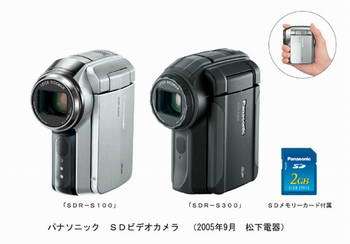Panasonic Unveils World's First SD Memory Card Based 3-CCD Digital Video Cameras

Panasonic, the leading brand for which Matsushita Electric Industrial Co., Ltd. is best known, today debuted the world's first 3-CCD digital video cameras SDR-S100 and SDR-S300 that record MPEG2 pictures onto SD Memory Cards. The new "SD Video Camera" series expands Panasonic's digital video camera lineup to meet a wide range of consumers' needs. The SDR-S100 will be available in Japan on October 15 and SDR-S300 on November 15.
The S100 and S300 incorporate Panasonic's experience and expertise in the professional and consumer digital video cameras. Panasonic revolutionized broadcast news gathering with its DVCPRO P2 series, the first professional digital video cameras featuring a solid-state memory card as recording medium. The SD Memory Card based S100 and S300 offer the mobility and convenience of a tape-less video camera. They also feature three CCDs (charge-coupled devices), the MEGA O.I.S. (optical image stabilizer) and MPEG2 Engine to deliver high picture quality.
The two models are the first products to utilize Panasonic's proprietary integrated platform for next-generation consumer electronic devices. "With this platform, the cameras simultaneously combine less power consumption, higher performance and compactness," said Mr. Naruo Yoshikawa, General Manager of Camcorder Category, Panasonic AVC Networks Company.
By adopting the postage-stamp sized SD Memory Card, Panasonic has succeeded in making the digital video cameras more compact, lightweight and mobile. The card also increases connectivity with other AV products. The S100 measures 49.9 × 96.7 × 80.4 mm and weighs 242 g without the battery, making it the smallest and lightest 3-CCD video camera to date.
As they do not require moving parts for storing data, the S100 and S300 are impervious to shocks and vibration as well as offering resistance to environmental extremes. The SD Memory Card reduces warm-up time, allowing a start-up of amazing 1.5 seconds. The card also makes recording easy - the cameras automatically find blank memory areas to stop users accidentally recording over images.
The two models can record video and still images in the widescreen 16:9 aspect ratio. Even after shooting, they offer the convenience of high-speed data transfer without using a cable. For example, when the SD Memory Card is popped into a card slot on the DVD recorder, the video data can be transferred to the hard disk drive eight times faster than normal speeds. Once the video is saved on the DVD recorder, it can be enjoyed on a large-screen VIERA TV with family and friends. When used with the included USB2.0 high-speed cable, the pictures (LP mode) can be transferred 22 times faster to the PC for editing.
Mr. Yoshikawa said, "The SD Memory Card is a de facto market standard in flash memory, accounting for 40 percent of the market. We are continuing to work on expanding the memory capacity and lowering the cost of this highly reliable and secure card."
The 3-CCD system, commonly used in professional video cameras, is employed to capture each of the primary colors of light, red, green and blue, for color accuracy. The Crystal and MPEG2 Engines process and detect image information to reproduce highly precise and true-to-life images.
Panasonic's MEGA O.I.S. (optical image stabilizer), a must for any compact cameras, detects and suppresses a slightest handshake, promising foolproof pictures. They feature the Leica Dicomar lens that captures clear and crisp images with detail and contrast.
Embodying Panasonic's ideas for comfort and ultimate operating ease, the main control buttons are arranged symmetrically - right-handers or left-handers can therefore operate it easily in one hand.
The S100 and S300 feature a large 2.8-inch LCD for easy viewing. They are identical except that the S300 has a more rugged design with carbon reinforced polymer used for the grip and LCD exterior.
They come with a 2-gigabyte SD Memory Card which can hold about 100 minutes of MPEG2 video (LP mode) or 1,280 3.1-megapixel (2,048 × 1,512) still pictures (fine mode).
"We believe solid-state memory based video cameras present an ideal solution for both professionals and consumers. Proving its value, our DVCPRO P2 series video cameras have been adopted as one of the official recording equipment at the Torino Olympics," said Mr. Yoshikawa.


















